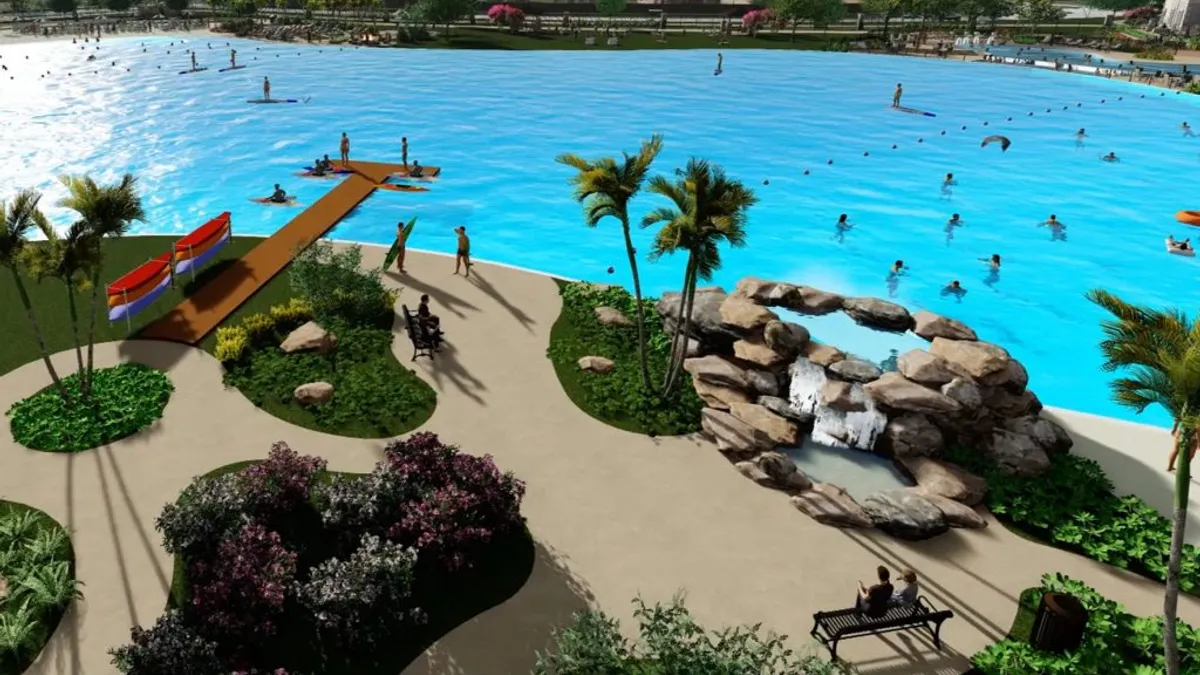Dive Brief:
- Developers for the $1 billion mixed-use Bayside development planned for the shores of Lake Ray Hubbard in Rowlett, Texas, reportedly shocked city officials at a special update meeting on July 26 by announcing their intentions to eliminate an 8-acre "crystal lagoon," a trolley system and a 1-acre fountain from the project, according to The Dallas Morning News. The development team, led by Tom D'Alesandro, also told the council that their buildout schedule would be approximately 15 years, almost four times as long as the previous developer, Bayside Land Partners, projected.
- D'Alesandro and member of his development group said that a crystal lagoon would not attract the business tenants necessary to fill the 1.7 million square feet of office space in the development and that features that were more natural to the area — a meadow, a natural lagoon, native Texas plants and trees and other regional features — would create a more authentic, unique place that would complement the pricey townhomes and business space they hope to add later on. The new plan includes a public park with a 5,000-person capacity for concerts and other events, plus a boulevard that would accommodate one-third of the retail originally planned for Bayside.
- Rowlett Mayor Tammy Dana-Bashian said the removal of the highly anticipated features, which Dana-Bashian said are what will draw much-needed retailers, would change the character of the development from "bold" to something "safe." D'Alesandro said the new plan meets the "realities of the market." Dana-Bashian also said that the new Bayside does not match up with the provisions of the public-private partnership that Rowlett has with developers and that the revised plan would need city approval. The city purchased the 257-acre parcel from the city of Dallas for $31.8 million back in 2015 but have been planning a major development there for approximately 15 years.
Dive Insight:
Developers are in a race to draw residents, retailers and corporate tenants to the wave of $1 billion-plus mixed-use developments that are either completed or in the works. And, according to commercial real estate firm JLL, the more developers can include in these projects, the bigger chance they have of becoming experiences rather than just places that meet a few needs like, for example, a residential building with retail on the ground floor.
This trend speaks to the desire to live, work and play in an urban environment, whether it's in a city or part of a suburban development designed to mimic one. For example, Bright Realty is adding a $1.5 billion "urban core" to its Castle Hills community in Lewisville, Texas. Plans for the new, mixed-use phase include a nine-story Class AA office building with 15,000 square feet of restaurant space on the ground floor, a park with outdoor entertainment space and multifamily housing built on top of 35,000 square feet of retail.
But not all suburbanites are interested in bringing the city way of life to their neighborhoods. The $4 billion Heartland Town Square development would create 1,500 construction jobs during each year of its projected 30-year development schedule and generate an estimated 26,000 permanent jobs for those in the Long Island, New York, region once it's completely built out, but locals have protested the project on the basis of several issues, including potential school overcrowding and water usage.
In the latest showdown with developer Jerry Wolkoff, Suffolk County officials voted to delay an agreement that would permit the project to hook up to the local sewer utility. Those opposed to the development have argued that the massive water needs of the project would draw down aquifers and create an additional 2.5 million gallons per day of wastewater. Wolkoff said if he's denied the sewer connection, he won't build the project.














